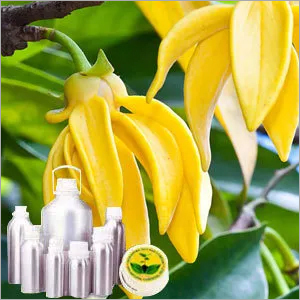Ylang Ylang Oil
 | Botonical Name | : | Canangaodorata |
 | CAS # | : | 8006-81-3 |
 | Country of Origin | : | India |
 | Color & Odor | : | Pale yellow clear liquid with Sweet floral-balsamic odor |
 | Solubility | : | Insoluble in water, soluble in alcohol and oils |
 | Specific Gravity | : | 0.9000 - 0.9610 @ 20°C |
 | Optical Rotation | : | NA |
 | Refractive Index | : | 1.4550 - 1.5840 @ 20°C |
 | Flash Point | : | >100°C |
 | Major Constituents | : | farnesene, Benzyl Benzoate, linalool, geranyl. |
 | Plant Part Used | : | Flowers |
 | Extraction Method | : | Steam Distillation |
DESCRIPTION:
Ylang Ylang' denotes 'flower of flowers'. There are several grades of Ylang Ylang Essential Oil, which are extracted at different times during the flower's lengthy distillation. CONSTITUENTS:
linalool, geranyl acetate, farnesene , caryophyllene, p-cresyl methyl ether, methyl benzoate, cinnamyl acetate, methyl salicylate, benzyl acetate, benzyl benzoate. AROMATIC SUMMARY / NOTE / STRENGTH OF AROMA:
A base note with a medium aroma, YlangYlang has a sweet, exotic, floral scent that is one of the most sought-after BLENDS WITH:
Bergamot, grapefruit, lavender and sandalwood. COMMON NAMES:
Flower of flowers.USES:
Its stimulating attributes are effective in dealing with frigidity and impotency. The constituents of this oil are beneficial for normalizing high level of blood pressure. Also used for curing infections of intestine, this oil is preferred by dermatologists for its skin beneficial value. The oil of ylang ylang accelerates hair growth. 


































